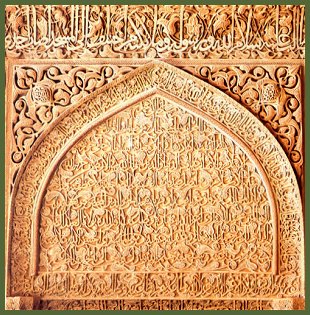 |
Persian Calligraphy
Prayer niche in the Friday Mosque, Isfahan - Built by Oljeitu in 1310. The Arabic script was adopted in Iran quite soon after the Islamic conquest of AD 642, largely because it was the official script of the new state into which Iran was incorporated. Calligraphy is the highest art form of the Islamic civilization, and like all forms of art that came into contact with Iran, it was enhanced and developed by the Persians. It was practised not only by professional calligraphers, but also by princes and nobles themselves. Calligraphers were an essential requirement for any self-respecting court, both to instruct the prince's children in the principles of the art and to produce manuscripts for the royal library. Under the Timurids and the Safavids, calligraphy experienced perhaps its most brilliant development. In the late 14th century Umar Aqta "with amputated hand", wrote a miniature Koran for Timur, which was so small that it could be fitted under the socket of a signet ring. When Timur disapproved of it because, according to a Prophetic tradition the Word of God should be written in big letters, the calligrapher produced another copy in which each was a cubit1 in length. The application of calligraphy to architectural surfaces also reached new heights during this period with entire surfaces of mosques covered with coloured tiles bearing decoration and magnificent calligraphic inscriptions. The Friday Mosque in Isfahan can be regarded as a model for every possible style of calligraphic decoration, beginning with the network of plaited Kufi in Oljeitu's prayer niche which is crowned by highly involved thuluth on a floral background and culmulating in large panels of elegant thuluth inscriptions of the 17th century. By the 16th century, Shiraz was among the forerunners of calligraphy study and production in the Islamic world; followed by Isfahan. Persian calligraphers excelled in all styles of writing; the elegant large
muhaqqaq, the finer rihani, and the heavy pliable thuluth script to name a few.
The art of calligraphy was much more than simply noting down texts. The calligrapher's pen, made from reed and according to strict rules was considered to be the 'cypress in the garden of knowledge'. *** In the early centuries, the style of writing was quite uniform throughout the Moslem World.
1. Cubit - an ancient measurement of length equal to the length of the arm between the wrist and the elbow; between 18" to 22" or 45cm to 56cm. Copyright shall at all times remain vested in the Author. No part of the work shall be used, reproduced, stored in a retrieval system, or transmitted in any form or by any means electronic, mechanical, photocopying, recording or otherwise, without the Author's express written consent. Copyright © 2000 K. Kianush, Art Arena |
